report
Download as pptx, pdf0 likes353 views
This document discusses various aspects of vowels and consonants in phonetics. It describes how vowels are produced with little airflow restriction, can carry pitch and loudness, and can stand alone without consonants. It provides examples of different types of vowels in words like "cat", "he", and "who". It also discusses diphthongs, nasalized vowels, and subclasses of consonants like stops, fricatives, affricates, sonorants, and obstruents. Finally, it briefly mentions tone languages that use pitch to distinguish words and intonation languages like English that do not.
1 of 17
Download to read offline
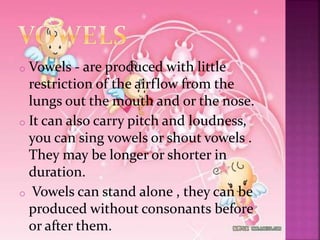

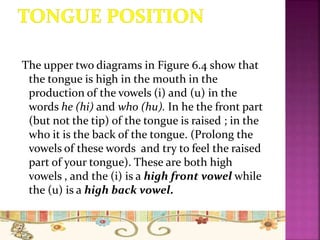

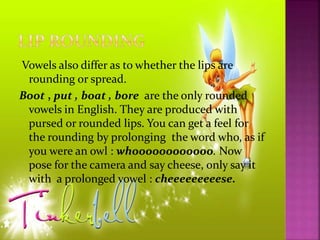

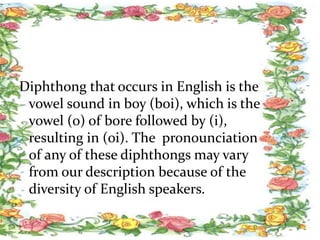
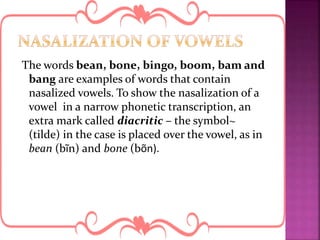


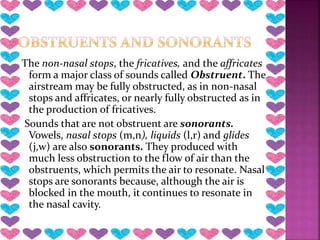



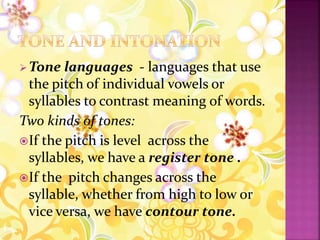
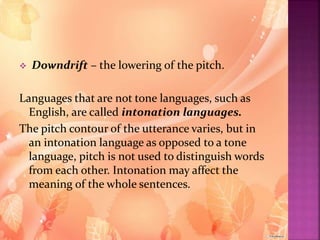

Ad
Recommended
English consonant sounds by Monir Hossen
English consonant sounds by Monir Hossen Monir Hossen
Ã˝
This document discusses places and manners of articulation for English consonants. It defines place of articulation as where in the vocal tract a consonant's narrowing occurs, such as bilabial, labiodental, dental, etc. Manner of articulation refers to how the airstream is affected, including stops, fricatives, approximants, affricates, and laterals. It also discusses voicing, whether vocal folds vibrate. The document provides detailed descriptions and diagrams of each place and manner of articulation to classify English consonant sounds.Consonant g1a
Consonant g1abolide162
Ã˝
This document outlines the consonant sounds of English, discussing their places and manners of articulation. It defines consonants as sounds produced with an obstruction of airflow from the lungs. It then describes the 8 places of articulation for English consonants: bilabial, labiodental, dental, alveolar, palato-alveolar, palatal, velar, and glottal. The document also discusses the 6 manners of articulation for English consonants: plosives, fricatives, affricates, nasals, laterals, and approximants. Tables provide an overview of the consonant phonemes in English organized by place and manner of articulation.Consonants presentation
Consonants presentationUniversidad de Costa Rica
Ã˝
The document discusses the classification of consonant sounds according to place, manner, and voicing. It explains that consonants are classified based on where in the vocal tract they are articulated (place), how they are articulated (manner), and whether the vocal cords vibrate (voiced or voiceless). Examples are provided to demonstrate the different places of articulation including bilabial, alveolar, velar, and others. Common consonant sounds in English are also illustrated using IPA symbols together with their classification.Phonetics Ppt
Phonetics PptJane Chien
Ã˝
The document discusses common problems with English vowel and consonant spelling, including:
- English has more vowel sounds than letters to represent them
- Vowel letters can represent long or short vowel sounds
- Consonant substitutions often involve replacing voiced sounds with unvoiced ones
It provides examples of rules for determining long and short vowel sounds based on spelling, and discusses how consonants like /Œ∏/ and /√∞/ can be confused with /t/ and /d/. The differences between consonants like / í/ and /j/ are also outlined.Sounds articulation process
Sounds articulation processIsrael Reyes Alvarez
Ã˝
This document discusses the articulation processes involved in speech production, focusing on voiced and unvoiced sounds and the organs responsible for speech. It details places of articulation for consonants such as labial, coronal, and dorsal, along with corresponding examples. Additionally, it explains the manner of articulation including types like stop, fricative, and approximant sounds.The Articulation Of Consonants
The Articulation Of ConsonantsIsabel gutierrez
Ã˝
The articulation of consonants involves the vocal cords and articulators like the lips, tongue, and soft palate. Consonants are formed by interrupting, restricting, or diverting airflow and can be described by their manner, place, and force of articulation. The manners include plosives, fricatives, nasals, and more. Place of articulation refers to where in the vocal tract the obstruction of airflow occurs, such as bilabial, dental, or velar. Force of articulation is whether the sound is voiced (vocal cords vibrate) or unvoiced, with the latter requiring more expelled air.Phoneme (2)
Phoneme (2)cengizcoban46
Ã˝
This document discusses phonemes, syllables, and syllabification. It begins by defining a phoneme as the smallest unit of sound in speech. There are 44 phonemes in English, represented by letters or letter combinations. A syllable contains at least one phoneme and can be broken into onset, nucleus, and coda. The nucleus is the core vowel sound. Minimal pairs are word pairs that differ by one phoneme, like "fan" and "van". The document also discusses phonological processes like vowel reduction and features of consonants in the International Phonetic Alphabet.The sounds of english
The sounds of englishJedalyn Salvador
Ã˝
The document discusses the classification of sounds in General American English. It is divided into three main sections: vowels, diphthongs, and consonants. For vowels, it describes their production and lists the 11 vowel sounds. For diphthongs, it explains their blending quality and lists the 3 diphthong sounds. For consonants, it classifies them by voicing, manner of articulation, and point of articulation, listing the various consonant sounds in each category.Voicing And Consonants
Voicing And ConsonantsDr. Cupid Lucid
Ã˝
This document discusses voicing and consonants in English. It describes the anatomy and functions of the larynx, including the vocal folds and their role in voicing. It explains how the position of the vocal folds produces voiced, voiceless, and fricative sounds. It also analyzes the four phases of articulation for plosive consonants and how they differ in initial, medial, and final positions based on voicing and aspiration. The document concludes that voicing is a complex phenomenon and has provided details on articulation of speech sounds.Classifications of consonants
Classifications of consonantsdeepa anand
Ã˝
The document discusses the classification of consonants according to their manner and place of articulation. It explains that consonants are produced by a constriction in the vocal tract and classified based on three dimensions: place of articulation, manner of articulation, and voicing. Place of articulation refers to where in the vocal tract the constriction occurs. Manner of articulation describes how narrow the constriction is and whether air flows through the nose. The document provides detailed descriptions of different manners of articulation including plosives, affricates, nasals, fricatives, lateral, and approximants. It also lists the place of articulation for various consonants and provides examples.GENERAL CLASSIFICATION OF VOWELS
GENERAL CLASSIFICATION OF VOWELSnorielr
Ã˝
This document discusses the classification of English vowels according to four criteria: tongue position, mouth openness, lip shape, and length. It outlines the categories of front, central, and back vowels based on where the highest point of the tongue is placed in the mouth. Vowels are also classified as close, semi-close, semi-open, and open based on the openness of the mouth. Vowels can be rounded or unrounded depending on lip shape. Finally, vowels are either long or short based on length. The document also provides examples of assimilation rules where the final consonant sound of one word changes when followed by another word based on place or manner of articulation.Phonetics and phonology ppt
Phonetics and phonology pptDewi Atin Surya
Ã˝
This document summarizes key aspects of phonetics, which is the study of speech sounds. It discusses phonology, the production and transmission of speech sounds, and the principal cavities and organs involved in speech. It also defines consonants and vowels, and describes the place and manner of articulation for different consonant sounds. Key terms covered include bilabial, alveolar, voiced, voiceless, stops, fricatives, nasals, laterals, and approximants. The document also briefly mentions vowels, diphthongs, triphthongs, and suprasegmentals like stress, pitch, and intonation.Place and manner of articulation ms espina
Place and manner of articulation ms espinaCarl Richard Dagalea
Ã˝
This document discusses phonetic concepts including place and manner of articulation, and provides examples to illustrate the differences between phones and phonemes. It also discusses vowel nasalization in English as an example of allophones. Specifically, it notes that vowels become nasalized before nasal consonants like [m], [n], and [ŋ]. This is an example of allophones, as the nasalized vs. oral distinction does not change the meaning of words. The document also provides examples of different allophones of the phoneme /t/ in English.Phonetics features of plosive
Phonetics features of plosiveNafis Kamal
Ã˝
Plosives are consonant sounds produced by stopping airflow in the vocal tract. The basic English plosives are voiceless t, k, p and voiced d, g, b. Plosives are articulated by closing the lips, alveolar ridge, or velar region. Plosives go through three stages - closing, compression with built up air pressure, and abrupt release. English plosives are distinguished by place of articulation (bilabial, lingua-alveolar, lingua-velar), voicing (voiced or voiceless), aspiration of initial sounds, and degree of muscular force in production.Teaching English Consonants
Teaching English Consonantsvictorgaogao
Ã˝
This document provides a summary of English consonants. It discusses the place and manner of articulation for different consonant sounds in English, including plosives, nasals, fricatives, affricates, and approximants. Diagrams are included to illustrate the places of articulation for various consonants like bilabial, alveolar, velar, and glottal sounds. The document also notes rules about aspiration, voicing, and allophonic variation for stops in English.Phonetics and Phonology: Consonants
Phonetics and Phonology: ConsonantsIhsan Ibadurrahman
Ã˝
The document discusses speech production and consonants. It defines phonetics and phonology, noting that phonetics studies how sounds are produced while phonology studies how sounds are organized mentally. It then describes the three areas of phonetics: articulatory, acoustic, and auditory phonetics. Next, it outlines the six types of airstream mechanisms and defines consonants as involving constriction while vowels involve open approximation. Finally, it details the four parameters used to describe speech sounds: voicing, place of articulation, manner of articulation, and whether the sound is nasal or oral.Lecture 1 Consonants
Lecture 1 ConsonantsHai Ha Do
Ã˝
This document provides an overview of phonetics and phonology. It defines phonetics as the study of speech sounds and their physical properties, while phonology examines the sound system of a language. It discusses the three areas of phonetics: articulatory, acoustic, and auditory phonetics. The document also defines consonants and vowels. It classifies consonants according to their place and manner of articulation, as well as according to voicing. The places of articulation include bilabial, labiodental, dental, alveolar, retroflex, palatoalveolar, palatal, velar, and glottal. Manners of articulation include stops, fricatives,English Fhonology (I Bimestre)
English Fhonology (I Bimestre)Videoconferencias UTPL
Ã˝
The document discusses English phonology, outlining its definitions, components, and classifications, including phonetics and phonemics. Key concepts include phonemes, allophones, and the various manners and places of articulation for consonants and vowels. It also provides symbols for different vowel and consonant phonemes along with phonetic features associated with speech sounds.Consonants
ConsonantsVinnytsya Language School
Ã˝
The document discusses consonant articulation, contrasting it with vowels based on airflow obstruction. It outlines the classification of consonants by place, manner, and voicing, detailing various categories such as stops, fricatives, and approximants. The content also touches on aspiration, voice onset time (VOT), and provides insights into different fricative sounds and their characteristics in English.Consonants of English
Consonants of EnglishMousa Mzuri
Ã˝
This document discusses the consonant sounds of English. It describes 5 categories of consonants: friction consonants like f and v; stop consonants like p and b; nasal consonants like m, n, and ng; lateral consonants like l; and gliding consonants like w, y, and r. For each category, it provides details on place and manner of articulation, voiced and voiceless pairs, distribution patterns, and examples to illustrate key points. The goal is to explain the production of all the consonant phonemes in English.English consonants and classification
English consonants and classificationMega Basith
Ã˝
This document provides an overview of phonology and phonetic transcription. It begins with background on speech sounds and the International Phonetic Alphabet (IPA) system for transcribing sounds. It then describes the classification of English consonants according to place of articulation (where in the vocal tract the sound is made), manner of articulation (how air flow is affected), and voicing (whether vocal folds vibrate). It provides details on different places of articulation like bilabial, alveolar, velar, and others. It explains manners of articulation such as stops, fricatives, approximants, affricates, and laterals. Finally, it discusses voicing and how sounds are producedSpeech sounds introduction
Speech sounds introductionDiana Martínez Salatín
Ã˝
The document provides an overview of speech sounds, focusing on their description, classification, and articulation. It discusses vowels, including the production of vowel sounds, and details consonantal articulations, including their voicing, place, and manner of articulation. It also introduces the cardinal vowel system and the International Phonetic Alphabet (IPA) as tools for understanding and categorizing speech sounds.Phonetics presentation part i
Phonetics presentation part iShermila Azariah
Ã˝
This document provides information on various linguistic concepts related to phonetics and morphology.
It begins with an overview of the key elements of English language phonology including phonetics, phonemes, and Received Pronunciation. It then discusses morphology, defining morphology, morphemes (free and bound), and provides examples.
The document also covers specific linguistic concepts in more depth including the individual speech sounds of vowels and consonants, describing their articulation and distribution. It provides a detailed analysis of English pure vowel sounds using the cardinal vowel diagram and IPA phonetic symbols. Place of articulator
Place of articulatorShekh Dhrubo
Ã˝
This document provides an overview of a lecture on phonetics. It introduces the lecturer, Rebecca Carroll, and lists relevant literature. The lecture covers the organs involved in sound production, including the airstream mechanisms, phonation, vocal tract, articulators, and places of articulation. It describes phonetic properties like manner of articulation, place of articulation, lip rounding, and provides charts showing the places of articulation. The document provides examples for students to practice identifying phonetic properties and sounds. It also gives a detailed articulatory description of the word "ship" as an example.Manner Of Articulation
Manner Of Articulationjdspider
Ã˝
The document discusses phonetics, which is the study of human speech sounds. It describes the organs involved in speech production, including the larynx, vocal cords, soft palate, and tongue. It explains the classification of sounds based on their manner of articulation (such as plosives, nasals, and fricatives), place of articulation, voicing, and other phonetic features. Key terms like pulmonic egressive airflow and voiced/voiceless are defined in the context of phonetic analysis.Phonetics - Manner of Articulation
Phonetics - Manner of ArticulationAjez Ahmad
Ã˝
The document discusses the different manners of articulation in phonetics and phonology. It describes stops, fricatives, affricates, approximants, and liquids. Stops are consonants produced by completely stopping airflow in the oral cavity. Fricatives are produced with a narrowing but not complete closure of the articulators, creating friction. Affricates begin as stops and end as fricatives. Approximants like liquids and glides involve close approximation but not complete closure of the articulators. The document provides examples and details on place and manner of articulation for each class of sounds.Phonetics: Consonants
Phonetics: ConsonantsSunny Stong
Ã˝
This document discusses the classification of consonant sounds according to their place of articulation in the vocal tract. It explains that consonants are sounds produced with some restriction of airflow, as opposed to vowels. The main places of articulation described are bilabial, labiodental, interdental, alveolar, palatal, velar, uvular, and glottal sounds. Each place is defined by where in the mouth the air flow is obstructed, such as with the lips or tongue touching different areas like the teeth, hard palate, soft palate or uvula.Phonetics & Phonology Mine.pptx
Phonetics & Phonology Mine.pptxKoukabKhan
Ã˝
This document provides an overview of phonetics and phonology. It defines phonetics as the scientific study of human speech sounds, and notes it has three branches: articulatory, auditory, and acoustic phonetics. Phonology is presented as the study of how sounds are organized in a particular language. Key concepts covered include the International Phonetic Alphabet (IPA), English speech organs and their functions, manner and place of articulation for English consonants and vowels, and phonetic transcription.classification of English vowels & consonants.docx
classification of English vowels & consonants.docxRabiaArshad45
Ã˝
This document provides a detailed overview of the consonants and vowels that make up the English phonological system. It describes the 44 sounds in English, including 20 vowels and 24 consonants. It discusses consonants based on their manner of articulation (stops, fricatives, nasals, etc.), place of articulation (bilabial, alveolar, velar, etc.), and voicing. It also describes the cardinal vowels, long/short vowels, diphthongs, and triphthongs that comprise the English vowel system. The vocal tract, articulators, and mechanisms of speech production are also explained.Pp31
Pp31sadiauetian
Ã˝
This document provides an introduction to phonetics and phonology. It discusses the branches of phonetics including acoustic phonetics, auditory phonetics, and articulatory phonetics. It describes the classification of sounds into consonants and vowels and the classification of consonants based on manner and place of articulation. It also discusses diphthongs, allophones, syllables, prosody, stress, rhythm, and intonation as aspects of phonology.More Related Content
What's hot (19)
Voicing And Consonants
Voicing And ConsonantsDr. Cupid Lucid
Ã˝
This document discusses voicing and consonants in English. It describes the anatomy and functions of the larynx, including the vocal folds and their role in voicing. It explains how the position of the vocal folds produces voiced, voiceless, and fricative sounds. It also analyzes the four phases of articulation for plosive consonants and how they differ in initial, medial, and final positions based on voicing and aspiration. The document concludes that voicing is a complex phenomenon and has provided details on articulation of speech sounds.Classifications of consonants
Classifications of consonantsdeepa anand
Ã˝
The document discusses the classification of consonants according to their manner and place of articulation. It explains that consonants are produced by a constriction in the vocal tract and classified based on three dimensions: place of articulation, manner of articulation, and voicing. Place of articulation refers to where in the vocal tract the constriction occurs. Manner of articulation describes how narrow the constriction is and whether air flows through the nose. The document provides detailed descriptions of different manners of articulation including plosives, affricates, nasals, fricatives, lateral, and approximants. It also lists the place of articulation for various consonants and provides examples.GENERAL CLASSIFICATION OF VOWELS
GENERAL CLASSIFICATION OF VOWELSnorielr
Ã˝
This document discusses the classification of English vowels according to four criteria: tongue position, mouth openness, lip shape, and length. It outlines the categories of front, central, and back vowels based on where the highest point of the tongue is placed in the mouth. Vowels are also classified as close, semi-close, semi-open, and open based on the openness of the mouth. Vowels can be rounded or unrounded depending on lip shape. Finally, vowels are either long or short based on length. The document also provides examples of assimilation rules where the final consonant sound of one word changes when followed by another word based on place or manner of articulation.Phonetics and phonology ppt
Phonetics and phonology pptDewi Atin Surya
Ã˝
This document summarizes key aspects of phonetics, which is the study of speech sounds. It discusses phonology, the production and transmission of speech sounds, and the principal cavities and organs involved in speech. It also defines consonants and vowels, and describes the place and manner of articulation for different consonant sounds. Key terms covered include bilabial, alveolar, voiced, voiceless, stops, fricatives, nasals, laterals, and approximants. The document also briefly mentions vowels, diphthongs, triphthongs, and suprasegmentals like stress, pitch, and intonation.Place and manner of articulation ms espina
Place and manner of articulation ms espinaCarl Richard Dagalea
Ã˝
This document discusses phonetic concepts including place and manner of articulation, and provides examples to illustrate the differences between phones and phonemes. It also discusses vowel nasalization in English as an example of allophones. Specifically, it notes that vowels become nasalized before nasal consonants like [m], [n], and [ŋ]. This is an example of allophones, as the nasalized vs. oral distinction does not change the meaning of words. The document also provides examples of different allophones of the phoneme /t/ in English.Phonetics features of plosive
Phonetics features of plosiveNafis Kamal
Ã˝
Plosives are consonant sounds produced by stopping airflow in the vocal tract. The basic English plosives are voiceless t, k, p and voiced d, g, b. Plosives are articulated by closing the lips, alveolar ridge, or velar region. Plosives go through three stages - closing, compression with built up air pressure, and abrupt release. English plosives are distinguished by place of articulation (bilabial, lingua-alveolar, lingua-velar), voicing (voiced or voiceless), aspiration of initial sounds, and degree of muscular force in production.Teaching English Consonants
Teaching English Consonantsvictorgaogao
Ã˝
This document provides a summary of English consonants. It discusses the place and manner of articulation for different consonant sounds in English, including plosives, nasals, fricatives, affricates, and approximants. Diagrams are included to illustrate the places of articulation for various consonants like bilabial, alveolar, velar, and glottal sounds. The document also notes rules about aspiration, voicing, and allophonic variation for stops in English.Phonetics and Phonology: Consonants
Phonetics and Phonology: ConsonantsIhsan Ibadurrahman
Ã˝
The document discusses speech production and consonants. It defines phonetics and phonology, noting that phonetics studies how sounds are produced while phonology studies how sounds are organized mentally. It then describes the three areas of phonetics: articulatory, acoustic, and auditory phonetics. Next, it outlines the six types of airstream mechanisms and defines consonants as involving constriction while vowels involve open approximation. Finally, it details the four parameters used to describe speech sounds: voicing, place of articulation, manner of articulation, and whether the sound is nasal or oral.Lecture 1 Consonants
Lecture 1 ConsonantsHai Ha Do
Ã˝
This document provides an overview of phonetics and phonology. It defines phonetics as the study of speech sounds and their physical properties, while phonology examines the sound system of a language. It discusses the three areas of phonetics: articulatory, acoustic, and auditory phonetics. The document also defines consonants and vowels. It classifies consonants according to their place and manner of articulation, as well as according to voicing. The places of articulation include bilabial, labiodental, dental, alveolar, retroflex, palatoalveolar, palatal, velar, and glottal. Manners of articulation include stops, fricatives,English Fhonology (I Bimestre)
English Fhonology (I Bimestre)Videoconferencias UTPL
Ã˝
The document discusses English phonology, outlining its definitions, components, and classifications, including phonetics and phonemics. Key concepts include phonemes, allophones, and the various manners and places of articulation for consonants and vowels. It also provides symbols for different vowel and consonant phonemes along with phonetic features associated with speech sounds.Consonants
ConsonantsVinnytsya Language School
Ã˝
The document discusses consonant articulation, contrasting it with vowels based on airflow obstruction. It outlines the classification of consonants by place, manner, and voicing, detailing various categories such as stops, fricatives, and approximants. The content also touches on aspiration, voice onset time (VOT), and provides insights into different fricative sounds and their characteristics in English.Consonants of English
Consonants of EnglishMousa Mzuri
Ã˝
This document discusses the consonant sounds of English. It describes 5 categories of consonants: friction consonants like f and v; stop consonants like p and b; nasal consonants like m, n, and ng; lateral consonants like l; and gliding consonants like w, y, and r. For each category, it provides details on place and manner of articulation, voiced and voiceless pairs, distribution patterns, and examples to illustrate key points. The goal is to explain the production of all the consonant phonemes in English.English consonants and classification
English consonants and classificationMega Basith
Ã˝
This document provides an overview of phonology and phonetic transcription. It begins with background on speech sounds and the International Phonetic Alphabet (IPA) system for transcribing sounds. It then describes the classification of English consonants according to place of articulation (where in the vocal tract the sound is made), manner of articulation (how air flow is affected), and voicing (whether vocal folds vibrate). It provides details on different places of articulation like bilabial, alveolar, velar, and others. It explains manners of articulation such as stops, fricatives, approximants, affricates, and laterals. Finally, it discusses voicing and how sounds are producedSpeech sounds introduction
Speech sounds introductionDiana Martínez Salatín
Ã˝
The document provides an overview of speech sounds, focusing on their description, classification, and articulation. It discusses vowels, including the production of vowel sounds, and details consonantal articulations, including their voicing, place, and manner of articulation. It also introduces the cardinal vowel system and the International Phonetic Alphabet (IPA) as tools for understanding and categorizing speech sounds.Phonetics presentation part i
Phonetics presentation part iShermila Azariah
Ã˝
This document provides information on various linguistic concepts related to phonetics and morphology.
It begins with an overview of the key elements of English language phonology including phonetics, phonemes, and Received Pronunciation. It then discusses morphology, defining morphology, morphemes (free and bound), and provides examples.
The document also covers specific linguistic concepts in more depth including the individual speech sounds of vowels and consonants, describing their articulation and distribution. It provides a detailed analysis of English pure vowel sounds using the cardinal vowel diagram and IPA phonetic symbols. Place of articulator
Place of articulatorShekh Dhrubo
Ã˝
This document provides an overview of a lecture on phonetics. It introduces the lecturer, Rebecca Carroll, and lists relevant literature. The lecture covers the organs involved in sound production, including the airstream mechanisms, phonation, vocal tract, articulators, and places of articulation. It describes phonetic properties like manner of articulation, place of articulation, lip rounding, and provides charts showing the places of articulation. The document provides examples for students to practice identifying phonetic properties and sounds. It also gives a detailed articulatory description of the word "ship" as an example.Manner Of Articulation
Manner Of Articulationjdspider
Ã˝
The document discusses phonetics, which is the study of human speech sounds. It describes the organs involved in speech production, including the larynx, vocal cords, soft palate, and tongue. It explains the classification of sounds based on their manner of articulation (such as plosives, nasals, and fricatives), place of articulation, voicing, and other phonetic features. Key terms like pulmonic egressive airflow and voiced/voiceless are defined in the context of phonetic analysis.Phonetics - Manner of Articulation
Phonetics - Manner of ArticulationAjez Ahmad
Ã˝
The document discusses the different manners of articulation in phonetics and phonology. It describes stops, fricatives, affricates, approximants, and liquids. Stops are consonants produced by completely stopping airflow in the oral cavity. Fricatives are produced with a narrowing but not complete closure of the articulators, creating friction. Affricates begin as stops and end as fricatives. Approximants like liquids and glides involve close approximation but not complete closure of the articulators. The document provides examples and details on place and manner of articulation for each class of sounds.Phonetics: Consonants
Phonetics: ConsonantsSunny Stong
Ã˝
This document discusses the classification of consonant sounds according to their place of articulation in the vocal tract. It explains that consonants are sounds produced with some restriction of airflow, as opposed to vowels. The main places of articulation described are bilabial, labiodental, interdental, alveolar, palatal, velar, uvular, and glottal sounds. Each place is defined by where in the mouth the air flow is obstructed, such as with the lips or tongue touching different areas like the teeth, hard palate, soft palate or uvula.Similar to report (20)
Phonetics & Phonology Mine.pptx
Phonetics & Phonology Mine.pptxKoukabKhan
Ã˝
This document provides an overview of phonetics and phonology. It defines phonetics as the scientific study of human speech sounds, and notes it has three branches: articulatory, auditory, and acoustic phonetics. Phonology is presented as the study of how sounds are organized in a particular language. Key concepts covered include the International Phonetic Alphabet (IPA), English speech organs and their functions, manner and place of articulation for English consonants and vowels, and phonetic transcription.classification of English vowels & consonants.docx
classification of English vowels & consonants.docxRabiaArshad45
Ã˝
This document provides a detailed overview of the consonants and vowels that make up the English phonological system. It describes the 44 sounds in English, including 20 vowels and 24 consonants. It discusses consonants based on their manner of articulation (stops, fricatives, nasals, etc.), place of articulation (bilabial, alveolar, velar, etc.), and voicing. It also describes the cardinal vowels, long/short vowels, diphthongs, and triphthongs that comprise the English vowel system. The vocal tract, articulators, and mechanisms of speech production are also explained.Pp31
Pp31sadiauetian
Ã˝
This document provides an introduction to phonetics and phonology. It discusses the branches of phonetics including acoustic phonetics, auditory phonetics, and articulatory phonetics. It describes the classification of sounds into consonants and vowels and the classification of consonants based on manner and place of articulation. It also discusses diphthongs, allophones, syllables, prosody, stress, rhythm, and intonation as aspects of phonology.Pp31
Pp31sadiauetian
Ã˝
This document provides an introduction to phonetics and phonology. It discusses the branches of phonetics including acoustic phonetics, auditory phonetics, and articulatory phonetics. It describes the classification of sounds into consonants and vowels and the classification of consonants based on manner and place of articulation. It also discusses diphthongs, allophones, syllables, prosody, stress, rhythm, and intonation as aspects of phonology.Phonetics, The Sounds of Language
Phonetics, The Sounds of LanguageDikha Wijanarko
Ã˝
This document provides an overview of phonetics and the sounds of language. It discusses sound segments and the identity of speech sounds. It describes the phonetic alphabet and how it is used to represent sounds. The document then focuses on articulatory phonetics, explaining places and manners of articulation for consonants. It discusses voiced and voiceless sounds, as well as nasal and oral sounds. Various ways of classifying consonants are presented. The document also covers vowels, including dimensions like tongue position and lip rounding. It describes concepts like tense/lax vowels, nasalization of vowels, and prosodic features. Tone and intonation are briefly discussed at the end.Vowels by saveeda hina
Vowels by saveeda hinasaveedahina
Ã˝
This document defines and describes different types of vowel sounds:
- Vowels are speech sounds made without obstruction of airflow in the vocal tract, unlike consonants.
- Vowels are classified based on tongue height and position (front, back, central), lip rounding, and length.
- The main types of vowels discussed are: monophthongs (single vowel sounds), diphthongs (combining vowel sounds), and rare triphthongs (three combining vowel sounds).
- Examples of different vowels are provided along with descriptions of their articulation. Cardinal vowels are introduced as reference points for describing other language vowels.Phonetic and phonology
Phonetic and phonology ssuser080991
Ã˝
This document provides information on phonetics and phonology. It discusses the differences between the two fields, with phonetics focusing on the physical aspects of sounds and phonology examining how sounds are structured and patterned in a language. Key concepts in phonetics include articulatory phonetics, acoustic phonetics, auditory phonetics, place and manner of articulation for consonants, vowel height, advancement and lip position. Phonology examines phonemes, allophones, minimal pairs, phonotactics and syllables. It provides examples to illustrate these linguistic concepts.325036360-ENGLISH-PHONETICS-AND-PHONOLOGY-ppt.ppt
325036360-ENGLISH-PHONETICS-AND-PHONOLOGY-ppt.pptIip Backspace
Ã˝
This document provides an overview of English phonetics and phonology. It discusses the production of speech sounds and the anatomy involved, including the larynx, articulators above the larynx like the pharynx, palate, tongue, teeth and lips. It describes vowels in terms of height, backness, rounding and tenseness. There are short, long and diphthong vowels in English. Consonants are classified by manner of articulation, place of articulation and voicing. The International Phonetic Alphabet is used to represent English speech sounds.Voice and Accent Training Module.pptx
Voice and Accent Training Module.pptxAditiGhai7
Ã˝
This document discusses the importance of voice and accent training. It explains that while someone may have a good knowledge of English grammar and vocabulary, communication can still be difficult without proper accent training. Voice and accent training teaches the sounds of English letters and enhances overall communication skills. It also helps professionally by allowing people to communicate more effectively in English, even if it is not their native language. The document then outlines several major factors that impact voice and accent, including phonetics, jaw and articulation exercises, vowel and consonant sounds, pronunciation, stress, and voice modulation. It provides details on phonetics and the classification of consonants into groups like plosives, nasals, fricatives, affricates, andConsonants 2
Consonants 2mpaviour
Ã˝
This document discusses phonetic symbols and their use in describing speech sounds. It covers the main places and manners of articulation used to produce consonants and vowels. Key points include:
- Phonetic symbols use a three-part label describing voicing, place, and manner of articulation.
- Places of articulation include bilabial, dental, alveolar, palatal, velar produced with different articulators like the lips, teeth and tongue.
- Manners include stops, nasals, fricatives, affricates, approximants, and trills which are distinguished by how the vocal tract is narrowed or blocked.
- Major classes are obstruents likespeechorgandanmanerofarticulationgroup5-141107091333-conversion-gate02.pdf
speechorgandanmanerofarticulationgroup5-141107091333-conversion-gate02.pdfAttallah Alanazi
Ã˝
This document discusses speech organs and the three dimensions of articulation. It defines speech organs as the parts of the body involved in producing speech sounds, including both passive organs like the lips, teeth, and palate, as well as active organs like the tongue. It then explains the three dimensions of articulation: voicing refers to whether sounds are voiced or voiceless; place of articulation describes where in the mouth sounds are produced; and manner of articulation is how the air flow is obstructed to make different speech sounds such as stops, fricatives, and nasals.English phonology course (3)
English phonology course (3)RafaelCalvache
Ã˝
The document provides information about English phonology and phonetics. It discusses several key topics:
1. Phonology studies the sounds of a language, while phonetics studies how speech sounds are produced.
2. English has a small set of phonemes (speech sounds) that include vowels and consonants. Learning phonemes rather than letters is important for pronunciation.
3. Other sections describe accents and dialects, the speech mechanism including articulators and places of articulation, manners of articulation for different consonant types, and challenges of the English spelling system.Gaby Soto
Gaby Soto GabySoto23
Ã˝
The document provides information about English phonology and phonetics. It discusses topics such as phonology, phonetics, phonemes, accents, dialects, articulators, speech sounds, voicing, places of articulation, consonants, and the speech mechanism. The key points are that phonology studies sounds in a language, phonetics studies speech sounds, phonemes are distinctive sounds in a language, accents and dialects affect pronunciation, articulators in the mouth produce speech sounds, voicing and place of articulation distinguish consonant sounds.Phonetics
PhoneticsDija Saifia
Ã˝
This document provides an overview of phonetics and phonology. It defines phonetics as the physical production and perception of speech sounds, while phonology is the study of how sounds are organized and used within a language. Phonetics analyzes all human speech sounds, while phonology analyzes the significant sounds of a particular language. The document also outlines the main branches of phonetics - acoustic, auditory, and articulatory phonetics. It describes voiced and voiceless sounds, and the place and manner of articulation for various consonant sounds like bilabials, dentals, velars, and approximants.Speech organ and manner of articulation
Speech organ and manner of articulationYanti95
Ã˝
This document discusses speech organs and the three dimensions of articulation. It defines speech organs as the parts of the body involved in sound production, including passive organs like the lips and alveolar ridge, as well as active organs like the tongue. It then explains the three dimensions of articulation - voicing, place of articulation, and manner of articulation. Voicing refers to whether vocal cords vibrate during sound production. Place of articulation is where in the mouth a sound is made. Manner of articulation describes how the air stream is modified, such as stops, fricatives, nasals, etc.phonetics-130930140522-phpapp02.ppt
phonetics-130930140522-phpapp02.pptKoukabKhan
Ã˝
This document provides an overview of phonetics and phonology. It defines phonetics as the physical production and perception of speech sounds, while phonology is the study of how sounds are organized and used within a language. Phonetics analyzes all human speech sounds, while phonology analyzes the significant sounds of a particular language. The document also outlines the main branches of phonetics - acoustic, auditory, and articulatory. It describes voiced and voiceless sounds, and the place and manner of articulation - including bilabial, labiodental, dental, alveolar, palatal, velar, glottal, stop, fricative, affricate, nasal, and approximantCsd 210 introduction to phonetics i and ii
Csd 210 introduction to phonetics i and iiJake Probst
Ã˝
This document provides an introduction to phonetics, which is the study of speech sounds. It defines phonetics and discusses the subfields of articulatory phonetics, acoustic phonetics, and clinical phonetics. Key concepts covered include phonemes, the International Phonetic Alphabet (IPA), ways of classifying vowels and consonants based on place and manner of articulation, and voicing. Vowels, diphthongs, and consonants are defined and examples of each are provided.Lecture-2-Phonetics-and-Phonology-06102022-014126pm.pptx
Lecture-2-Phonetics-and-Phonology-06102022-014126pm.pptxMuhammadMaaz818451
Ã˝
This document discusses English phonetics and phonology. It begins by defining short vowels, long vowels, and diphthongs using the International Phonetic Alphabet (IPA). Examples of each are provided. The difference between voiced and voiceless consonants is explained. Voiced consonants involve vocal cord vibration while voiceless consonants do not. Aspirated and unaspirated consonants are also discussed. The concept of minimal pairs, which are pairs of words that differ by one sound only, is introduced as a tool for analyzing sounds. Key phonetic concepts like voicing, aspiration, diphthongs and triphthongs are defined. Videos are provided for practicing different vowel and consonantAnalyzing pronunciation error of the second semester student in stain pare...
Analyzing pronunciation error of the second semester student in stain pare...Fitrianti Risman
Ã˝
This document is a small project analyzing pronunciation errors of intermediate level 2 students in an International English Course in Parepare, Indonesia. Specifically, it examines students' ability to produce the dental fricative sounds [θ] and [ð]. The project was created by Fitrianti and submitted to the State Islamic College of Parepare in 2010. It provides background on pronunciation and defines dental and fricative sounds. It also reviews literature on categories of fricatives and the specifics of dental fricatives. The goal is to analyze how students produce these sounds and what errors they make.Phonetics ( Introduction to Linguistics )
Phonetics ( Introduction to Linguistics )Romulo Mulianto
Ã˝
This document provides an introduction to phonetics. It defines phonetics as the study of speech sounds and notes there are three types: acoustic, auditory, and articulatory. It describes vowels as sounds with an open air passage and consonants as sounds where the air stream is restricted. It discusses place and manner of articulation for different consonant sounds. It also outlines the organs of speech involved in sound production and the International Phonetic Alphabet used to represent speech sounds.Ad
report
- 1. o Vowels - are produced with little restriction of the airflow from the lungs out the mouth and or the nose. o It can also carry pitch and loudness, you can sing vowels or shout vowels . They may be longer or shorter in duration. o Vowels can stand alone , they can be produced without consonants before or after them.
- 2. Example : The vowel in Cat , the tongue is low in the mouth with the tongue tip forward, behind the front teeth.
- 3. The upper two diagrams in Figure 6.4 show that the tongue is high in the mouth in the production of the vowels (i) and (u) in the words he (hi) and who (hu). In he the front part (but not the tip) of the tongue is raised ; in the who it is the back of the tongue. (Prolong the vowels of these words and try to feel the raised part of your tongue). These are both high vowels , and the (i) is a high front vowel while the (u) is a high back vowel.
- 4. The vowel (ᴂ) in hack (hack) is produced with the front pat of the tongue low in the mouth, similar to the low vowel (a), but with the front rather than the back part of the tongue lowered. Say “ hack, hah, hack, hah, hack, hah . . . “ and you should feel your tongue moving forward and the back in the low part of you mouth.
- 5. Vowels also differ as to whether the lips are rounding or spread. Boot , put , boat , bore are the only rounded vowels in English. They are produced with pursed or rounded lips. You can get a feel for the rounding by prolonging the word who, as if you were an owl : whoooooooooooo. Now pose for the camera and say cheese, only say it with a prolonged vowel : cheeeeeeeeese.
- 6. ÔÇûA diphthong is a sequence of two vowel sounds. ÔÇûDiphthongs are present in the phonetic inventory of many languages, including english. ÔÇûMonophthongs are simple vowels that we have studied so
- 7. Diphthong that occurs in English is the vowel sound in boy (boi), which is the vowel (o) of bore followed by (i), resulting in (oi). The pronounciation of any of these diphthongs may vary from our description because of the diversity of English speakers.
- 8. The words bean, bone, bingo, boom, bam and bang are examples of words that contain nasalized vowels. To show the nasalization of a vowel in a narrow phonetic transcription, an extra mark called diacritic – the symbol~ (tilde) in the case is placed over the vowel, as in bean (bĩn) and bone (bõn).
- 9. In languages like French, Polish, and portuguese, nasalized vowels occur without nasal consonants. The french word meaning “sound” is son (sõ). The n in the spelling is not pronounced but indicates that the vowel is nasal .
- 10. Stops and affricates belong to the class of noncontinuants. There is totally obstruction of the airstream in the oral cavity. Nasal stop are included although air does flow continuously out the nose. All other consonants, and all vowels, are continuants, in which the stream of air flows continuously out of the mouth.
- 11. The non-nasal stops, the fricatives, and the affricates form a major class of sounds called Obstruent. The airstream may be fully obstructed, as in non-nasal stops and affricates, or nearly fully obstructed as in the production of fricatives. Sounds that are not obstruent are sonorants. Vowels, nasal stops (m,n), liquids (l,r) and glides (j,w) are also sonorants. They produced with much less obstruction to the flow of air than the obstruents, which permits the air to resonate. Nasal stops are sonorants because, although the air is blocked in the mouth, it continues to resonate in the nasal cavity.
- 12. In recognition of this fact linguists place the obstruents, nasal stops, and liquids in a subclass of consonants called consonantal, from which the glides are excluded. Here are some terms used to form subclasses of consonantal sounds. --Labials (p) (b) (m) (f) (v) (w) Labial sounds are those articulated with the involvement of the lips. They include the class of bilabial sounds (p) (b) and (m), the labiodentals (f) and (v), and the labiovelars (w).
- 13. --Coronals (œ¥) (√µ) (t) (d) (n) (s) (z) ( É) ( í) ( ß) ( §) (l) (r) coronal sounds are articulated by raising the tongue blade. Coronals include the interdentals (œ¥) (√µ), the alveolars (t) (d) (n) (s) (z), the palatals ( É) ( í), the affricates ( ß) ( §), and the liquids (l) (r). --Anteriors (p) (b) (m) (f) (v) (œ¥) (√µ) (t) (d) (n) (s) (z) Anterior sounds are consonants produced in the front part of the mouth, that is, from the alveolar area forward. They include the labials, the interdentals, and the alveolars.
- 14. -- Sibilants (s) (z) ( É) ( í) ( ß) ( §) Another class of consonantal sounds is characterized by an acoustic rather than an articulatory property of its members. The friction created by sibiliants produces a hissing sound, which is a mixture of high-frequency sounds.
- 15. ÔÉòTone languages - languages that use the pitch of individual vowels or syllables to contrast meaning of words. Two kinds of tones: ÔÇûIf the pitch is level across the syllables, we have a register tone . ÔÇûIf the pitch changes across the syllable, whether from high to low or vice versa, we have contour tone.
- 16.  Downdrift – the lowering of the pitch. Languages that are not tone languages, such as English, are called intonation languages. The pitch contour of the utterance varies, but in an intonation language as opposed to a tone language, pitch is not used to distinguish words from each other. Intonation may affect the meaning of the whole sentences.
- 17. Thank youforlisteningandcooperation God bless !!! Chapter 6 “Phonetics” Reporters : Loile Gonzales & Rosy Marie Sugabo.
